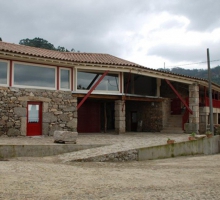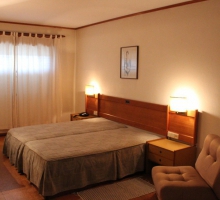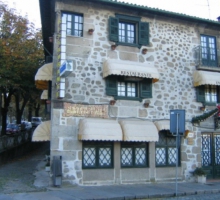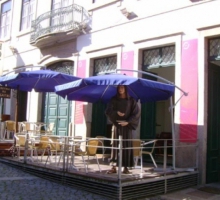Schedule:
8h to 18h30
Price:
- Entrance fee to the Cathedral 2€
- Visit to the Museum, Cathedral, Chapels and Coro Alto - 5€;
- Visit to the Cathedral, Chapels and Coro Alto - 3€;
- Visit to the Museum - 3€.
The tickets can be acquired in the Cathedral.
Guided visits: Monday to Friday 10,00h; 11,30h; 14,30h; 16h.
It is available to pray the Chapel of Nossa Senhora da Piedade, entrance by Rua do Souto.
Saint Mary of Braga Cathedral, is the source of Portugal´s devotion to the Virgin Mary and a splendid testament to this two thousand-year-old city. The cathedral has been remodeled numerous times since its inception in tje 11th century. Archbishop Rodrigo de Moura Teles (D. Rodrigo 1704-1728) is responsible for initiating the conversation to Baroque architecture which predominates today.
The cathedral in Braga is the oldest in Portugal and the richest of the monuments in this city. Tradition has it that the diocese of Braga was created in the iii century; but historical confirmation only goes back to the year 400. The present building is actually built on the site of another religious construction, possibly an earlier cathedral.
The exterior, with two towers on the façade, is very characteristic of the great Portuguese Romanesque cathedrals, though radical alterations have taken place over the centuries. A late 15th century galilee (porch) was closed in the 18th century by a very lovely iron grille which the archbishop, Dom Diogo de Sousa (1505-1532) had built to protect the chancel. The huge, carved stone coat-of-arms of archbishop, Dom Rodrigo de Moura Teles (1704-1728) was placed on the front, and the oratory and coping of the towers were built in the first quarter of the 18th century.
The interior with a nave and two aisles, transept and east end with five chapels is extremely austere. During the baroque period large windows were put in, altars were changed and walls covered with stucco and paintings; so the cathedral gradually turned into a celebratory festival, an appeal to the senses.
Dom Diogo de Sousa introduced a number of changes, namely to the very lovely vaulting, designed by the architect Juan of Castile at the beginning of the 16th century, a lost stone retable and altar frontal. He conserved, however, the magnificent, 14th century, French image of St. Mary of Braga.
The architectural style was something quite new to the Braga of that time; so much so that the city, not quite knowing how to evolve it further, found it easier to return to the old, familiar Mannerist style.
The cloister, dating from the beginning of the 19th century; replaced a Gothic cloister which was demolished at the end of the 18th century. It links the Treasury with the chapels of Dom Lourenço Vicente, the archbishop who rebuilt the Chapel of Kings (Capela dos Reis), and that of Our Lady of Pity (Nossa Senhora da Piedade). The former contains the Gothic tomb of the archbishop, and also the tombs of Henry of Burgundy and Teresa of Leon, the parents of the first king of Portugal, Afonso Henriques.
The chapel of Our Lady of Pity was founded by Dom Diogo de Sousa in 1513 and contains his tomb, the work of an unknown Coimbra artist, but possibly the one who sculpted the tombs of the parents of the first king of Portugal in the previous chapel. The original image of Senhora do Leite, the work of another Coimbra artist, the unknown Master of the Royal Tombs, is now in this chapel. The rococo retable of Our Lady of Blessed Memory (Nossa Senhora da Boa Memória) is also worthy of note.
Two other independent chapels form part of the monumental assemblage of Braga cathedral, that of St. Gerald (São Geraldo) which was constructed originally in the 12th century, though down through the centuries it has undergone a series of alterations, primarily during the baroque period though its façade was completely reconstructed in the restoration carried out in the 1940s.
Location: Braga
8h to 18h30
Price:
- Entrance fee to the Cathedral 2€
- Visit to the Museum, Cathedral, Chapels and Coro Alto - 5€;
- Visit to the Cathedral, Chapels and Coro Alto - 3€;
- Visit to the Museum - 3€.
The tickets can be acquired in the Cathedral.
Guided visits: Monday to Friday 10,00h; 11,30h; 14,30h; 16h.
It is available to pray the Chapel of Nossa Senhora da Piedade, entrance by Rua do Souto.
Saint Mary of Braga Cathedral, is the source of Portugal´s devotion to the Virgin Mary and a splendid testament to this two thousand-year-old city. The cathedral has been remodeled numerous times since its inception in tje 11th century. Archbishop Rodrigo de Moura Teles (D. Rodrigo 1704-1728) is responsible for initiating the conversation to Baroque architecture which predominates today.
The cathedral in Braga is the oldest in Portugal and the richest of the monuments in this city. Tradition has it that the diocese of Braga was created in the iii century; but historical confirmation only goes back to the year 400. The present building is actually built on the site of another religious construction, possibly an earlier cathedral.
The exterior, with two towers on the façade, is very characteristic of the great Portuguese Romanesque cathedrals, though radical alterations have taken place over the centuries. A late 15th century galilee (porch) was closed in the 18th century by a very lovely iron grille which the archbishop, Dom Diogo de Sousa (1505-1532) had built to protect the chancel. The huge, carved stone coat-of-arms of archbishop, Dom Rodrigo de Moura Teles (1704-1728) was placed on the front, and the oratory and coping of the towers were built in the first quarter of the 18th century.
The interior with a nave and two aisles, transept and east end with five chapels is extremely austere. During the baroque period large windows were put in, altars were changed and walls covered with stucco and paintings; so the cathedral gradually turned into a celebratory festival, an appeal to the senses.
Dom Diogo de Sousa introduced a number of changes, namely to the very lovely vaulting, designed by the architect Juan of Castile at the beginning of the 16th century, a lost stone retable and altar frontal. He conserved, however, the magnificent, 14th century, French image of St. Mary of Braga.
The architectural style was something quite new to the Braga of that time; so much so that the city, not quite knowing how to evolve it further, found it easier to return to the old, familiar Mannerist style.
The cloister, dating from the beginning of the 19th century; replaced a Gothic cloister which was demolished at the end of the 18th century. It links the Treasury with the chapels of Dom Lourenço Vicente, the archbishop who rebuilt the Chapel of Kings (Capela dos Reis), and that of Our Lady of Pity (Nossa Senhora da Piedade). The former contains the Gothic tomb of the archbishop, and also the tombs of Henry of Burgundy and Teresa of Leon, the parents of the first king of Portugal, Afonso Henriques.
The chapel of Our Lady of Pity was founded by Dom Diogo de Sousa in 1513 and contains his tomb, the work of an unknown Coimbra artist, but possibly the one who sculpted the tombs of the parents of the first king of Portugal in the previous chapel. The original image of Senhora do Leite, the work of another Coimbra artist, the unknown Master of the Royal Tombs, is now in this chapel. The rococo retable of Our Lady of Blessed Memory (Nossa Senhora da Boa Memória) is also worthy of note.
Two other independent chapels form part of the monumental assemblage of Braga cathedral, that of St. Gerald (São Geraldo) which was constructed originally in the 12th century, though down through the centuries it has undergone a series of alterations, primarily during the baroque period though its façade was completely reconstructed in the restoration carried out in the 1940s.
Location: Braga




